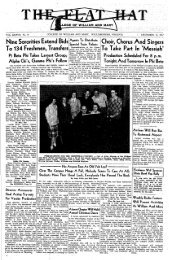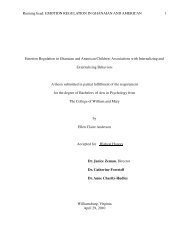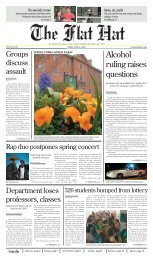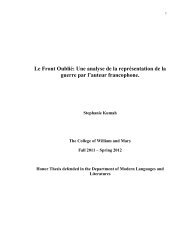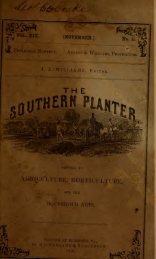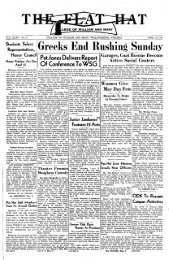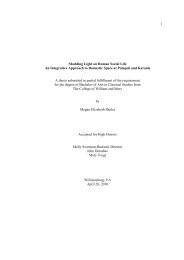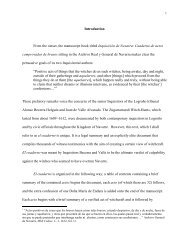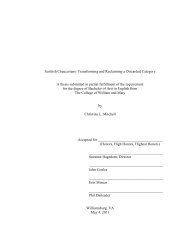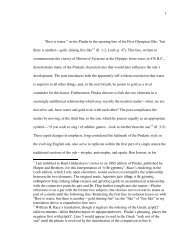Southern planter : devoted to agriculture, horticulture, and the ...
Southern planter : devoted to agriculture, horticulture, and the ...
Southern planter : devoted to agriculture, horticulture, and the ...
You also want an ePaper? Increase the reach of your titles
YUMPU automatically turns print PDFs into web optimized ePapers that Google loves.
440 THE SOUTHERN PLANTER.<br />
tered indiscriminately over his fielda. In<br />
<strong>the</strong> most busy season it often happens that<br />
a great deal of time is lost in catching<br />
working animals that are let out on pastures<br />
while <strong>the</strong> men eat dinner. In <strong>the</strong><br />
heat of a hot day, as at noon, horses <strong>and</strong><br />
oxen would do much better in <strong>the</strong> stables<br />
if supplied with green food. For such<br />
purpose no farmer should be without <strong>the</strong><br />
necessary quantity of clover <strong>to</strong> be used as<br />
soiling. We do not refer <strong>to</strong> that grown on<br />
meadow l<strong>and</strong> with grasses, but <strong>to</strong> clover<br />
produced on meadow l<strong>and</strong> heavilymnnured.<br />
Such clover will be succulent, <strong>and</strong> while<br />
it furnishes a highly nutritive feed for<br />
working animals, it prevents <strong>the</strong>m from<br />
having a desire <strong>to</strong> consume large quantities<br />
of water. Clover grown in <strong>the</strong> manner<br />
referred <strong>to</strong>, would produce <strong>the</strong> second<br />
season three crops. After each cutting it<br />
shohld be heavily <strong>to</strong>p-dressed. If <strong>the</strong><br />
pastures are bare from being over-s<strong>to</strong>cked,<br />
or parched by <strong>the</strong> heat of summer, <strong>the</strong> cat-<br />
tle should be fed on clover or o<strong>the</strong>r soiling.<br />
The value of it for increasing <strong>the</strong> quantity<br />
<strong>and</strong> quality of milk <strong>and</strong> butter, will soon<br />
be unders<strong>to</strong>od by any person who pursues<br />
such a course. This system of practice<br />
has its influence in saving time. If <strong>the</strong><br />
fences are bad, or that cattle roam in <strong>the</strong><br />
w^oods, by <strong>the</strong> feeding of special green<br />
food in a particular place thus causing cattle<br />
<strong>to</strong> come in search of it, much time may<br />
be saved. We know of a shiftless, disorderly<br />
farmer—<strong>and</strong> perhaps <strong>the</strong>re are oth-<br />
ers as well as he—who drives his cattle<br />
three or four miles <strong>to</strong> be milked, often w^hen<br />
above <strong>the</strong>ir knees in mud. He has several<br />
horses <strong>to</strong> spare, <strong>and</strong> milk cans growing<br />
rusty for want of use. He does not estimate<br />
<strong>the</strong> loss arising from such a practice.<br />
His cattle travel in coming home twice a<br />
day <strong>to</strong> be milked, <strong>and</strong> returning <strong>to</strong> <strong>the</strong> pasture,<br />
make four journeys equal <strong>to</strong> twelve<br />
miles — when <strong>the</strong> roads are muddy<br />
<strong>the</strong> labor is much increased—<strong>the</strong> feet of<br />
<strong>the</strong> cattle become subject <strong>to</strong> disease<br />
while travelling <strong>the</strong>y are not feeding, <strong>and</strong><br />
consequently not supplying <strong>the</strong> raw mate-<br />
rial from which <strong>to</strong> make flesh, milk or butter—<strong>the</strong>y<br />
dung on <strong>the</strong> road <strong>and</strong> its manu-<br />
rial effects are lost <strong>to</strong> <strong>the</strong> pasture— anil in<br />
addition <strong>to</strong> <strong>the</strong>se losses, arising from carelessness<br />
or a want of " order upon <strong>the</strong><br />
farm," <strong>the</strong> time of a man or boy is also<br />
lost in making <strong>the</strong> journeys referred <strong>to</strong>.<br />
Working Farmer.<br />
Boot <strong>and</strong> Shoe Trade.<br />
In <strong>the</strong> month of May, 1818, <strong>the</strong> good<br />
sloop called <strong>the</strong> Delight came in<strong>to</strong> <strong>the</strong> port<br />
of New York, freighted at Bos<strong>to</strong>n with a<br />
full cargo of boots <strong>and</strong> shoes, consigned<br />
<strong>to</strong> Spoflbrd & Tiles<strong>to</strong>n, <strong>the</strong> first boot <strong>and</strong><br />
shoe-jobbers of importance in New York,<br />
who <strong>the</strong>n commenced supplying <strong>the</strong> shipping<br />
dem<strong>and</strong> from this port instead of<br />
Bos<strong>to</strong>n.<br />
These gentlemen were <strong>the</strong>refore <strong>the</strong> first<br />
<strong>to</strong> introduce, extensively, <strong>the</strong> wholesale<br />
boot <strong>and</strong> shoe trade in<strong>to</strong> this city. The<br />
manufacture was confined at that time <strong>to</strong><br />
New Engl<strong>and</strong>, whence <strong>the</strong>y received supplies<br />
on commission. The trade rapidly<br />
extended, but in 1829 <strong>the</strong>re were only<br />
four jobbing houses in this branch of in-<br />
dustry.<br />
The large sales of boots <strong>and</strong> shoes for<br />
shipping induced Messrs. Spofford & Tile-<br />
s<strong>to</strong>n <strong>to</strong> invest capital in a line of ships <strong>to</strong><br />
ports in <strong>the</strong> South, for which <strong>the</strong>y became<br />
agents as well as principal owners, <strong>and</strong><br />
which being successful, led <strong>the</strong>m <strong>to</strong> become<br />
large ship owners, <strong>and</strong> at length <strong>to</strong><br />
ab<strong>and</strong>on <strong>the</strong> boot <strong>and</strong> shoe trade <strong>to</strong> o<strong>the</strong>rs.<br />
The boot <strong>and</strong> shoe manufacture of this city<br />
<strong>and</strong> its environs is <strong>the</strong>relbre of modern<br />
date. It now forms one-third of <strong>the</strong> whole<br />
manufacturing power of <strong>the</strong> country.<br />
New Engl<strong>and</strong> <strong>and</strong> Pennsylvania still retaining<br />
two thirds. This proportion is rapidly<br />
changing in favor of New Yoik. In<br />
this city <strong>the</strong>re are about fifty-five boot <strong>and</strong><br />
shoe jobbing houses, doing business <strong>to</strong> <strong>the</strong><br />
extent of fifteen <strong>to</strong> sixteen millions of dollars<br />
yearly.<br />
Common goods, such as men's pegged<br />
boots <strong>and</strong> brogans, women's pegged <strong>and</strong><br />
common sewed shoes <strong>and</strong> gaiters are manufactured<br />
in <strong>the</strong> villages of New Engl<strong>and</strong>,<br />
namely: Lynn, Haverhill, Worcester, Millford,<br />
Natick, R<strong>and</strong>olph, Abing<strong>to</strong>n, Reading,<br />
Danvers, George<strong>to</strong>wn, S<strong>to</strong>ugh<strong>to</strong>n, <strong>and</strong><br />
several o<strong>the</strong>r places in <strong>the</strong> State of Mas-<br />
sachusetts.<br />
The better kinds of goods, such as men's<br />
<strong>and</strong> women's fine sewed boots <strong>and</strong> shoes<br />
are manufactured in this city, in Newark,<br />
N. J., <strong>and</strong> o<strong>the</strong>r small places adjacent.<br />
There is but one o<strong>the</strong>r branch of manufacturing<br />
industry that has increased so<br />
rapidly as <strong>the</strong> boot <strong>and</strong> shoe business, <strong>and</strong><br />
that is <strong>the</strong> clothing trade.<br />
There are some boot <strong>and</strong> shoe jobbers



